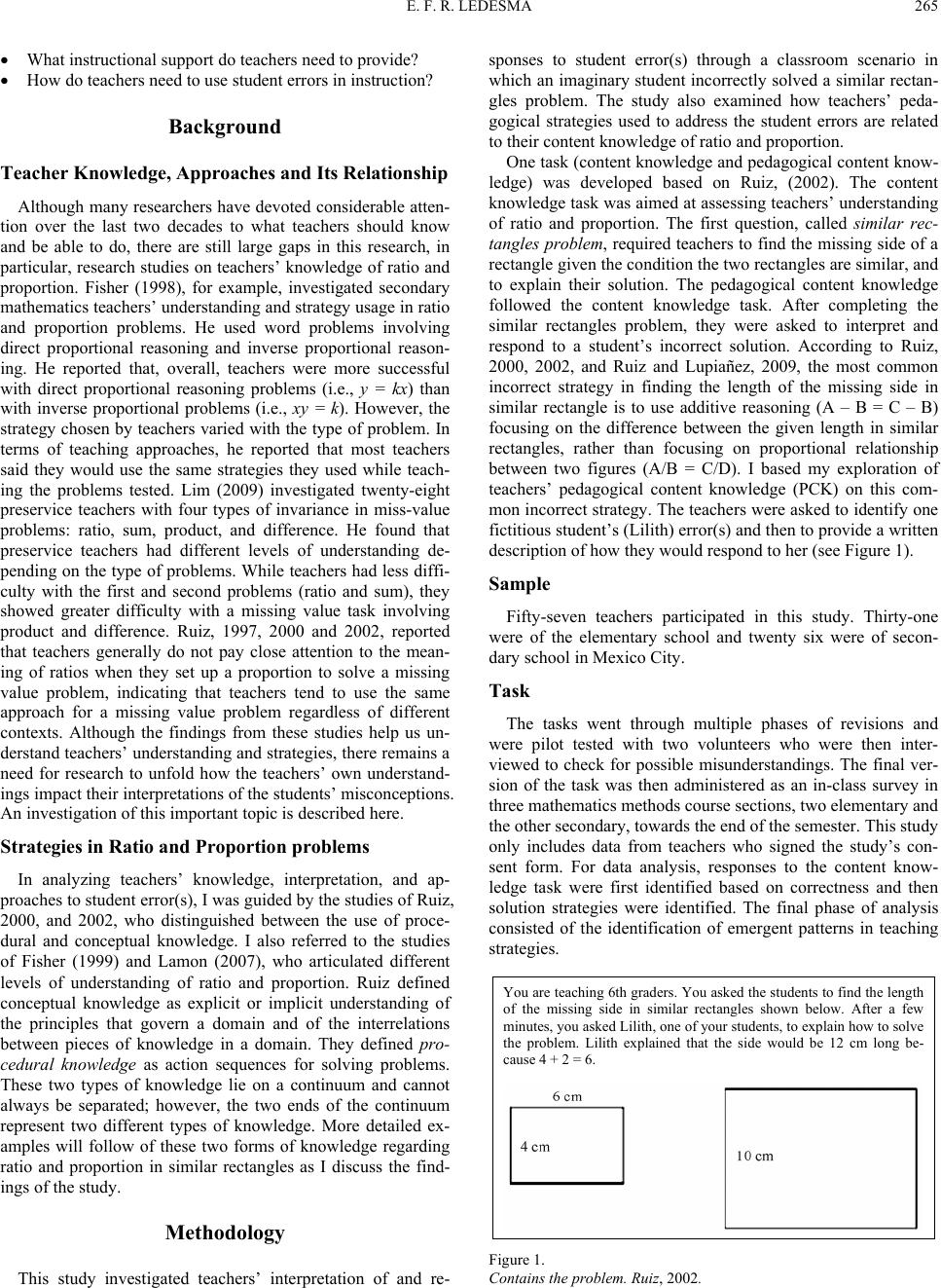
E. F. R. LEDESMA 265
What instructional support do teachers need to provide?
How do teachers need to use student errors in instruction?
Background
Teacher Knowledge, Approaches and Its Relationship
Although many researchers have devoted considerable atten-
tion over the last two decades to what teachers should know
and be able to do, there are still large gaps in this research, in
particular, research studies on teachers’ knowledge of ratio and
proportion. Fisher (1998), for example, investigated secondary
mathematics teachers’ understanding and strategy usage in ratio
and proportion problems. He used word problems involving
direct proportional reasoning and inverse proportional reason-
ing. He reported that, overall, teachers were more successful
with direct proportional reasoning problems (i.e., y = kx) than
with inverse proportional problems (i.e., xy = k). However, the
strategy chosen by teachers varied with the type of problem. In
terms of teaching approaches, he reported that most teachers
said they would use the same strategies they used while teach-
ing the problems tested. Lim (2009) investigated twenty-eight
preservice teachers with four types of invariance in miss-value
problems: ratio, sum, product, and difference. He found that
preservice teachers had different levels of understanding de-
pending on the type of problems. While teachers had less diffi-
culty with the first and second problems (ratio and sum), they
showed greater difficulty with a missing value task involving
product and difference. Ruiz, 1997, 2000 and 2002, reported
that teachers generally do not pay close attention to the mean-
ing of ratios when they set up a proportion to solve a missing
value problem, indicating that teachers tend to use the same
approach for a missing value problem regardless of different
contexts. Although the findings from these studies help us un-
derstand teachers’ understanding and strategies, there remains a
need for research to unfold how the teachers’ own understand-
ings impact their interpretations of the students’ misconceptions.
An investigation of this important topic is described here.
Strategies in Ratio and Proportion problems
In analyzing teachers’ knowledge, interpretation, and ap-
proaches to student error(s), I was guided by the studies of Ruiz,
2000, and 2002, who distinguished between the use of proce-
dural and conceptual knowledge. I also referred to the studies
of Fisher (1999) and Lamon (2007), who articulated different
levels of understanding of ratio and proportion. Ruiz defined
conceptual knowledge as explicit or implicit understanding of
the principles that govern a domain and of the interrelations
between pieces of knowledge in a domain. They defined pro-
cedural knowledge as action sequences for solving problems.
These two types of knowledge lie on a continuum and cannot
always be separated; however, the two ends of the continuum
represent two different types of knowledge. More detailed ex-
amples will follow of these two forms of knowledge regarding
ratio and proportion in similar rectangles as I discuss the find-
ings of the study.
Methodology
This study investigated teachers’ interpretation of and re-
sponses to student error(s) through a classroom scenario in
which an imaginary student incorrectly solved a similar rectan-
gles problem. The study also examined how teachers’ peda-
gogical strategies used to address the student errors are related
to their content knowledge of ratio and proportion.
One task (content knowledge and pedagogical content know-
ledge) was developed based on Ruiz, (2002). The content
knowledge task was aimed at assessing teachers’ understanding
of ratio and proportion. The first question, called similar rec-
tangles problem, required teachers to find the missing side of a
rectangle given the condition the two rectangles are similar, and
to explain their solution. The pedagogical content knowledge
followed the content knowledge task. After completing the
similar rectangles problem, they were asked to interpret and
respond to a student’s incorrect solution. According to Ruiz,
2000, 2002, and Ruiz and Lupiañez, 2009, the most common
incorrect strategy in finding the length of the missing side in
similar rectangle is to use additive reasoning (A – B = C – B)
focusing on the difference between the given length in similar
rectangles, rather than focusing on proportional relationship
between two figures (A/B = C/D). I based my exploration of
teachers’ pedagogical content knowledge (PCK) on this com-
mon incorrect strategy. The teachers were asked to identify one
fictitious student’s (Lilith) error(s) and then to provide a written
description of how they would respond to her (see Figure 1).
Sample
Fifty-seven teachers participated in this study. Thirty-one
were of the elementary school and twenty six were of secon-
dary school in Mexico City.
Task
The tasks went through multiple phases of revisions and
were pilot tested with two volunteers who were then inter-
viewed to check for possible misunderstandings. The final ver-
sion of the task was then administered as an in-class survey in
three mathematics methods course sections, two elementary and
the other secondary, towards the end of the semester. This study
only includes data from teachers who signed the study’s con-
sent form. For data analysis, responses to the content know-
ledge task were first identified based on correctness and then
solution strategies were identified. The final phase of analysis
consisted of the identification of emergent patterns in teaching
strategies.
You are teaching 6th graders. You asked the students to find the length
of the missing side in similar rectangles shown below. After a few
minutes, you asked Lilith, one of your students, to explain how to solve
the problem. Lilith explained that the side would be 12 cm long be-
cause 4 + 2 = 6.
Figure 1.
Contains the problem. Ruiz, 2002.